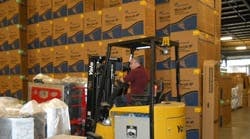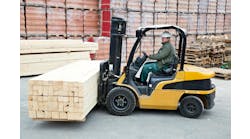It’s been a long, hot summer for American businesses. Many have been trying to grow their profit margins by shrinking expenses wherever possible. Some have done it through labor cuts, others by cutting their capital equipment purchases, and still others—in desperation—have done both. Those are more reflexive than strategic moves, and therefore much easier in the short run. Being strategic is more difficult because it requires study of costs and business patterns. The rewards are great, however, because they last longer.
Tony DiFraia learned that lesson 15 years ago just by mastering the mysteries of his lift truck fleet. He’s operations manager for Homans Associates (www.homans.com), a distributor of HVAC/R and mechanical insulation products. Prior to 1996 Homans’ business was much simpler—the company sold insulation and sheet metal. But as the housing market expanded and contracted, Homans added air conditioning, furnaces and condensers to its offerings to better insulate it from weaknesses in any one area in supplying building contractors.
Managing this broader mix of materials required a bigger facility and a better material handling strategy. To formulate both Homans worked with its local material handling equipment dealer, Northland Industrial Truck Co. (NITCO) (www.nitco-lift.com), one of New England’s biggest Yale and Hyster dealers.
Homans moved from its 45,000-square-foot low-ceilinged facility to a 90,000-square-foot warehouse in Wilmington, Mass., with more vertical space. NITCO helped design the flow through Homans’ new warehouse, taking advantage of the 16- to 18-foot uprights for vertical storage maximization.
Order selectors pick from both sides of their 100-foot aisles and 20 feet vertically into the air. NITCO designed 51-inch and 60-inch aisles. The narrow aisles helped to maximize square-foot and cubic-foot storage and fit more products in a given space.
To accommodate Homans’ three Yale walkie riders and electric lift trucks, NITCO laid out 12- to 14-foot aisles in another section of the facility.
In total, Homans leases 15 lift trucks from NITCO for its Wilmington facility.
Lift truck fleet management has helped Homans weather the upturns and downturns in the construction market. Over the years this company went from one simple Yale lift truck to adding a few more, plus a couple Basiloid (www.basiloid.com), squeeze trucks and a Landoll Drexel (www.landoll.com) swing mast order picker.
“We worked with NITCO to find the equipment that would make it easier to move our products,” DiFraia says. “NITCO also convinced us to go with a Drexel order picker so we could go down the aisles and stock side to side without turning around. We went to Basiloid attachments so we could lift equipment coming in off the trailers, and we’ve added clamp trucks for different forms of insulation. NITCO has proven they’re not just a vendor, they’re partners. We’re loyal to each other.”
Today Homans runs eight-hour shifts and each operator is responsible for their own piece of equipment. They’re moving product for the entire shift, outside of lunch and breaks.
Leasing Considerations
Dave Brady, national account manager for NACCO Material Handling Group (www.nmhg.com), manufacturer of Yale and Hyster lift trucks, says that while giving operators a sense of ownership of their lift trucks is a plus, most lift truck fleets are leased. That makes fleet sizing and utilization critical.
“Fleet sizing is still not getting the attention it deserves,” he says. “There’s a quick reduction in cost if you can rightsize the fleet. The reason companies go to leasing from buying is they would never turn them over otherwise. They’d end up holding them too long and thus create too big a fleet. But even if you rightsize you still have to deal with the guy who takes a ride on an order picker just to get somewhere as opposed to what it was designed to be doing.”
Those random transports add time to the lift truck usage meter and contribute to overtime costs. And when you sign up for a fair market value (FMV) lease with a maintenance contract, your costs depend on usage—and discipline.
“During the recession, companies that were doing these leases with maintenance didn’t have to be as disciplined in the rotation of trucks because very rarely in a customer’s application do you see all trucks being used exactly the same way,” says Nick Adams, business development manager for Mitsubishi Caterpillar Forklift America (MCFA) (www.mcfa.com). “You might have 10 people operating trucks on the first shift but only five on second shift. Well if five of those operators keep jumping on the same five trucks those trucks will have higher usage. During the recession, because things slowed down, there wasn’t as much risk of trucks exceeding the contract hours for the lease and maintenance. What we’re seeing now is this lack of rotation and fleets getting into overtime situations. A good manager will understand their usage to make sure they’ve rightsized their fleet.”
For example, say a fleet has 50 trucks on a 60-month FMV lease with a maintenance contract. If the manager reduced that to 45 trucks, he could save $36,000 a year, assuming an average cost of $600 a month. But if that manager isn’t careful about rotating those trucks to balance the hours, assuming an overtime rate of $3.85 an hour, with four units going 10% over their 2,000 hours, or 200 hours each, that would negate that $36,000 savings.
Rental Fills Gaps
Even in a weak economy companies may have seasonal peaks. Short-term lift truck rental can help accommodate those bursts in activity, but unless these rentals are tracked closely, a company’s budget can take a substantial hit.
Adams offers the example of a container manufacturer which in 2010 spent $37,000 on short-term rentals. So far through the first six months of 2011 that company has already spent almost $28,000 on rentals. In fact it is on track to spend about 48% more in 2011 than in 2010. They tend to justify this because their business is so closely associated with consumer demand and subject to seasonal peaks, and an economic surge earlier this year drove their short-term rental higher. But according to Adams, the dilemma for any fleet manager is separating what is seasonal demand from true sustainable demand.
“Fleet managers know that once they make a commitment on a lease, it’s painful to get out of that lease if you decide you don’t need that truck later on,” he says. “So this company is very disciplined when adding to its leased fleet.”
Separating Leased
from Rental
One of the fundamentals of rightsizing involves separating one’s core fleet from what’s needed for short-term rental. But you also have to understand how your company budgets its expenses. There are capital budgets, operational budgets and maintenance budgets, and during economic hard times the capital budget may be frozen. That’s when short-term rentals come out of one of the other two budgets, but trouble may ensue as short-term rentals become long-term; 6, 12, 18 months.
“It could cost the company more in the long-run if they don’t have money to purchase or employ a capital lease and they start overusing the short-term rental,” says Mike McKean, fleet management sales and marketing manager with lift truck manufacturer Toyota Material Handling USA. “The best practice for a fleet manager is to use a fleet management system to measure their fleet. That helps quantify the maintenance spend, utilization and number of lift trucks at any time.”
Five-year leases used to be the norm. Now, with the volatility in the economy and in business ebbs and flows, McKean says managers are starting to think that’s too long.
“They might have started out saying we need to pick 4,500 pounds, but two years into the lease they realize they’re not moving that weight anymore,” he explains. “They’re now moving 2,500 pounds, so you have a much larger truck than what you need but you’re committed to that lease. That’s where short-term rentals can help save the day. So you may well pay a premium for a rental which includes maintenance, but at least you won’t be put in a situation where you’ll idle 10-15 leased trucks.”
Fleet Sizing Rules
of Thumb
Joe LaFergola, manager of business and information solutions with lift truck manufacturer The Raymond Corp. (www.raymondcorp.com), offers the following rules of thumb for anyone analyzing their fleet sizing strategy:
• Make sure you have the right model. If you’re lifting less than 14% of the time—one hour of lift for every seven hours of operation—that means you’re using a truck that has the capability of lifting primarily for horizontal transport. Rather than using a counterbalanced truck in that situation, the first thing to do in rightsizing that fleet is make sure you have the right model type. In this case LaFergola would recommend replacing the counterbalanced truck with an electric pallet jack.
• Look at the number of hours you’re putting on your trucks over the entire enterprise. Every business has business cycles. Grocery picks up a month or two before Thanksgiving, paper supply picks up a month or two before school starts, candy picks up between Valentine’s Day and Easter. “We try to track not only the number of hours a person puts on a truck but when they put them on the truck,” LaFergola says. “How many trucks are you using at any given time?”
If you picture your business cycle as a sine wave, you want a certain percentage—say, 80-95%—of your trucks on the floor at any given time doing work, he adds. Depending on the size of the fleet there can be a low of 80% for small fleets, meaning eight on the floor and two for rotating for scheduled maintenance in case of a breakdown. However, with a large fleet, even 90% isn’t acceptable for LaFergola. “I want 95%,” he says. “I’m not going to spend $300,000 just to have 10 lift trucks sitting in the corner and waiting.”
• Once you hit your sweet spot and reduce your fleet down to its bare essentials, peak times can be filled by rental. Implement a short-term rental program for the peak months.
These are no-brainers for a lift truck fleet manager. But for a plant or distribution center manager whose other responsibilities call for getting shipments in and out on time, sometimes rules get bent or broken when business takes unpredicted turns. That’s why it’s so important to revisit fleet size and configuration once business returns to normal—or a new normal.



